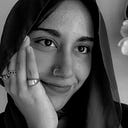The legacy of artist Anna Molka Ahmed
Pakistan immensely benefited from the efforts she made.
Anna Molka Ahmed was born in England to Polish and Russian parents in 1917, she became an incredible Scholar and Artist, who pioneered the Fine Arts in Pakistan when she held the art department at Punjab University.
Her background in painting, sculpture, and design studies was from London but she took Pakistan as her home when she moved here with her husband in 1939 before partition.
This is the story of her excellence, resilience and passion for teaching. Through memoirs and other readings by her students and people who knew her personally we see her strong personality, bold, dynamic and witty.
Her character shines in her painting style, her style owning to the expressionists, used bright vivid colors, thick paint, impasto technique, combining her european influence, she painted a range of subjects, and supposedly eschewed carefully planned painting.
She painted with a creative impulse cementing self-expression through arts in her students. She was a great sculptor, she made busts of many famous people around, one renowned sculpture from her is of a blind man. Who she actually found asking for alms and invited into her home.
Ajaz Anwar recalls the time with his mentor, Anna.
…In pursuit of her painting expeditions, she braved summer heat looking for appealing spots. Those were not necessarily saleable vistas. “Looking for the extraordinary out of the seemingly ordinary” would be the motif. She would break the rules that she prescribed for us. A very bright warm colour would occasionally appear in the background.
Imagine this young women, holding the frontier of art education at age 22, in 1940 as appointed at Punjab university, for the Arts and craft department open to female students ( the first of its kind).
She wrote extensively, critiqued on artists around the world, designing syllabi for bachelors and later masters. She held regular exhibitions of her art. She wanted a scholarly environment for art students.
Since she arrived in the subcontinent before Pakistan’s independence. The chaos surrounding the partition caused a drastic decrease in the number of students only 5 or 6 remained but art practice continued. we can imagine history unfolding while she perseveres to make art expansive to society back then. She would visit colleges seeking art students, convincing them and their parents for careers in art. She also introduced art courses in other institutions, In her words;
A country cannot progress without art, which expresses feeling, opinion, taste of society and people.
If we take a look at the art circles in 1950s/60s/70s we would see three movements emerging in pakistan namely expressionism, abstraction and realism. She was among the revolutionary artists such as Shakir Ali, khalid Iqbal and colin david, who were responsible for shaping these movements. Naturally she had many students, and left many celebrated artists to carry her work.
She actually has the First of many titles, She held the first Art exhibition in the country, the first women Professor emeritus in the country, the first to bring her students outdoor to paint indigenously.
Her importance in the art history of pakistan cannot undermined because it was through her a whole generation of women artists started formal practice, working in institutions throughout the country.
“Infact she has been the facilitator of a movement that made the proactive role of women artists a possibility.”
writes Nilofur Farrukh
Anna or called Mollie in her inner circle had pain and struggles in her personal life, even when she separated from her husband (also a recognized painter) she stood determined, she had a permanent office in Punjab university, she raised her two daughters, she was so confident. I can only imagine sitting in one of her classes knowing all this that I’m writing about now and just living those moments of learning art from her like her other students, that would be invaluable for sure.
Her volatile personality, her vim and vigor, the love she had for her adoptive country, carried her through the tough times. When you look back and see the hurdles she had to overcome, one realizes what a remarkable person she was and what she was able to accomplish. There are so many who were her colleagues and students who went on to reach great heights and have always remembered her with pride. – Zahra David( Anna’s daughter)
We can see a shift in her painting themes as time passed, for example she painted ‘Resurrection’ ‘Heaven’ ‘Hell’ ‘The dance of death’ and more in the later part of her life.
She was awarded the Taghma e Imtaiz in 1963, the Pride of Performance in 1979, and the Quaid-i Azam Award in 1982. She passed away in 1994, lahore. Leaving an incredible legacy behind, which still inspires many. Her story is one of my favourites.
